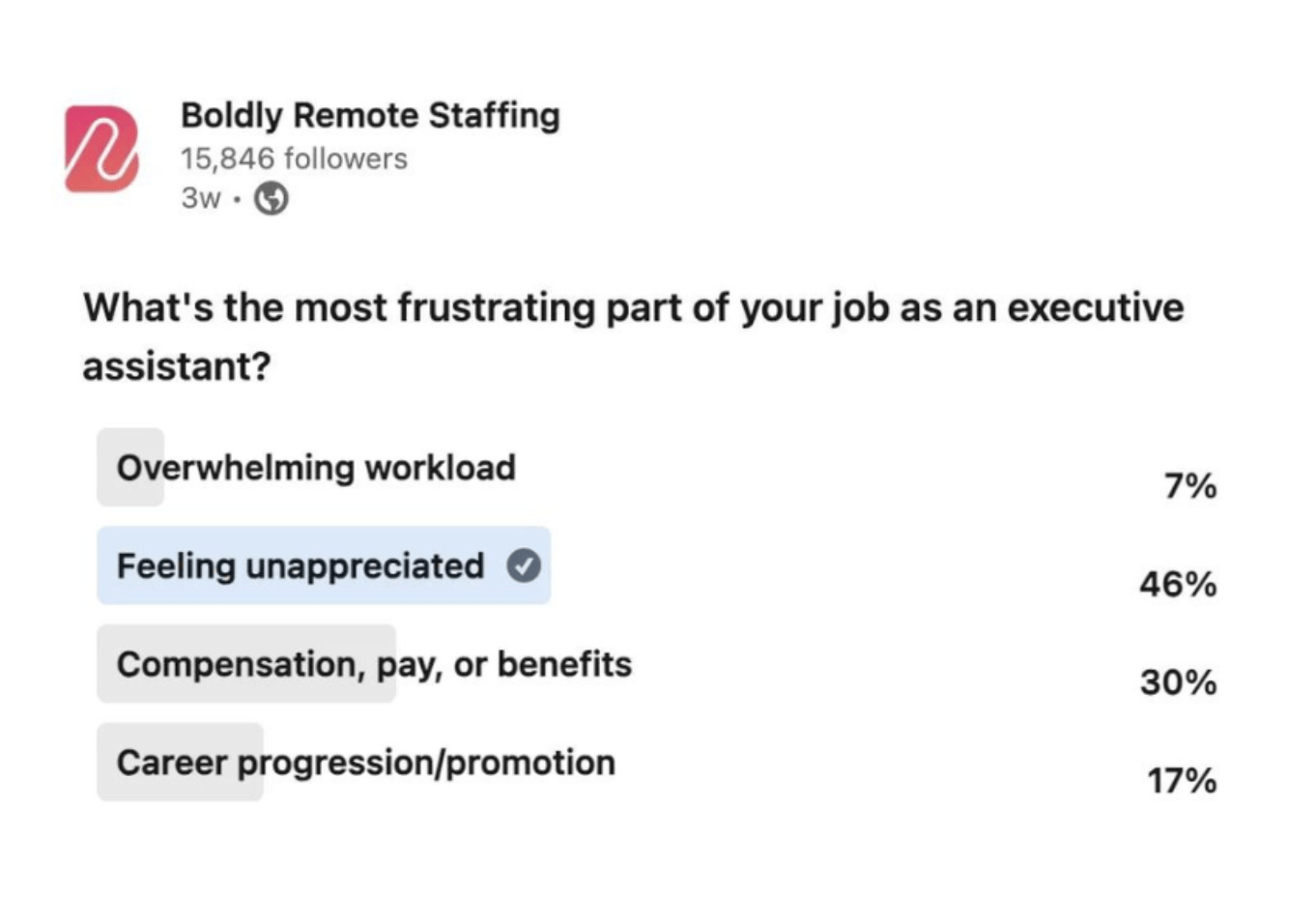A rockstar executive assistant is the ultimate productivity strategy. But what happens when they leave?
It’s a challenge to lose any good employee. But today’s EAs do more than manage calendars and email inboxes. Their role has evolved from admin help to strategic partner. So what pushes them out the door?
We polled our followers on LinkedIn to learn the top executive assistant frustrations.


This article will explore these frustrations and the three top reasons for executive assistant turnover — with advice on how to prevent it (and keep your trusted executive assistant happy).
We’ll start with the top frustration of feeling unappreciated — the result of an always-on culture combined with burnout.
Turnover Culprit #1: Always-On Culture
This is the primary reason premium EAs seek out careers at Boldly — they’re burned out, stressed out, and tired of working long hours on top of long commutes. With the demands and responsibilities of a C-Level executive assistant, work-life balance isn’t easy to come by!
Their real job description means serving as the nucleus of a team, managing what, when, and how things get done. But a relentless, “always-on,” company cultures blur work-life boundaries.
This becomes a persistent prompt to escape the pressure cooker.
HBR puts it like this: “Given the demands on the leaders, the hours can be long, hard, and stressful for their EAs. Most assistants understand and accept being on-call 24/7.”
Here’s how it happens.
The Executive Assistant’s Endless Task List
EAs deal with a steady surge of tasks. That’s part of their job, right? Yes—to a point. But what happens to the wizards of getting-things-done when their to-do lists get so packed that a nine-to-five workday won’t cut it?
The intricacy of these responsibilities, coupled with the pressing urgency of each, creates situations where work feels endless. This also means any sense of progress can feel fleeting.
Unrealistic Deadlines And Pressures
In C-level executive support roles especially, deadlines are strict and timeframes condensed, leaving little room for error.
This surfaces in a type of “workload whiplash.” While highly adaptable, assistants can become frustrated when projects suddenly change direction. Especially when it’s common practice.
To reduce the whiplash, consider involving them early on, ensuring they understand the overarching goals. That will help them stay nimble with you, rather than because of you.
Juggling simultaneous high-stakes projects and tasks is complex is hard enough. The pressure to perform flawlessly under these constraints gets mentally and physically draining pretty fast.
In other words, burnout.
Executive Assistants And Burnout Syndrome
Burnout is a silent career killer. It’s gotten so bad—and widespread—the WHO has now included it in their International Classification of Diseases.
A Kronos study found that 95% of HR leaders admitted employee burnout is “sabotaging workforce retention.” And EAs are not immune.
As the weeks and months of ceaseless pressure mount, the negative impact on an executive assistant’s well-being becomes too much.
A specific contributing factor for executive assistant burnout is they’re often unsung heroes, shouldering heavy loads that fly beneath the radar. They make their executives look great—but their contributions can go unnoticed.
Read more: An Easy Retention Hack: Say Thank You
Assess Your Executive Assistant’s Stress Levels
With these factors in mind, keeping an open connection with your executive assistant can pay dividends in retention.
- Sync Up: Schedule regular one-on-one meetings with your EA to discuss their workload, challenges, and any potential signs of burnout. Then address them accordingly.
- Assess Workloads & Bottlenecks: Look at your EA’s workload. Are there any areas where tasks can be streamlined or even eliminated? When you open up the conversation, it’s easier for them to talk frankly about workload problems and concerns.
- Set Realistic Expectations: Work with your EA to set realistic expectations and deadlines for projects and tasks. Yes, it’s the real world and urgent things come up. The best EAs get that—and are skilled enough to keep things moving forward in those situations.
- Provide Resources & Support: Offer resources like AI tools, training opportunities, and support systems to help your EA manage workload while building new skills.
- Say Thank You: It might not be a solution, but acknowledging the juggling your executive assistant does can go a long way!
Turnover Culprit #2: Compensation Concerns
In the United States, the average executive assistant salary is between $35–60 an hour.
However, executive assistants can earn jaw-dropping salaries. (Think $400k or more, according to the Wall Street Journal!) Plus, EA pay is on the rise across the board, which means if your EA feels underpaid compared to industry benchmarks, greener pastures can start calling.
For premium EAs in a remote-work world, higher-paying positions are more accessible than ever.
So, if you’re evaluating a new hire (or want to make sure your current EA is well taken care of), consider these common compensation concerns.
Feeling Underpaid For An Unrealistic Workload
Executive assistants aren’t immune to overwhelm. While EAs are known for going the extra mile (or ten!), a workload that simply doesn’t fit into a standard workday is likely unsustainable.
After all, if they’re paid a salary for 40 hours of work per week, each hour they work beyond that dilutes the value a company places on their time, effort, and skill.
Mind The (Pay) Gap
Assistants may question the pay difference when they perform tasks similar to their execs. The question gets raised: “Why do they get paid more than me when it feels like I’m doing their work for them?”
It’s certainly not an apples-to-apples comparison. But if an EA has already been going above and beyond their job description, dissatisfaction may soon follow.
Benefits And Perks Matter In The Executive Suite
Benefits are a big deal for executive assistants. Like all of us, they want more than just a good salary. They look for things like healthcare coverage, retirement plans, and other perks.
While this is standard fare for W2 employees and in-house hires, the contract, gig, or pool-solution freelancers struggle the most here.
(At Boldly, we pay special attention here. That’s why all of our remote executive assistants are W2 employees with great benefits to match.)
Turnover Culprit #3: Career Progression Challenges
Executive assistants often face unclear career paths.
Unlike other roles with clear hierarchies and promotion opportunities, EAs may feel stuck and unable to advance. While they often work with the leaders of a company, their track to actually becoming one can be opaque.
Does Your Executive Assistant Have A Future With You?
This lack of upward mobility can be demotivating and prompt them to seek roles with better growth prospects. And when the role is seen as mainly supportive rather than strategic, EAs may feel underutilized. They have more to contribute, but no obvious opportunity to do so!
That’s why a career roadmap for EAs who want to advance can boost retention.
One study found that 76% of employees promoted within 3 years of their hire date stayed with the company. But the employees who stay in their position? Less than 50% of them stay to the 3 year mark—and only 38% to year 5.
A clear and compelling future can keep you a step ahead of turnover. However, advancement opportunities need to be met with chances to improve their skills.
Skill Development Creates Satisfaction, Growth, And Retention
Take Kali, a remote executive assistant from our team. She said, “Growing my experience and applying my skills with dynamic and inspiring clients can’t be beaten.”
And what does one of her inspiring clients think about working with her?
Josh McNary, a marketing technologist, put it like this: “Kali has helped me and my business get to the next level. With both administrative and marketing support she has given me the freedom to expand my business.”
Happy, growth-oriented, skilled-up EAs make for ecstatic executives with growing businesses.
The Bright Spot: When Executive Assistants Get Promoted
While they can be the unsung heroes of the C-suite, executive assistants are capable of commanding a seat at the board table.
For example, you might’ve heard of Bill Gates’s former assistant, Steve Ballmer. He went on to become Microsoft’s president and now, the world’s 5th richest person. Or Ann Hiatt, former assistant to Jeff Bezos, Eric Schmidt, and Marissa Mayer. Today, she’s leveraged years of expertise into founding her own consulting company.
The truth about executive assistants is their proximity to leadership helps them gain insights, skills, and experiences most employees aren’t privy to. And this can translate into extremely valuable, competent, and seasoned leaders.
The Best EAs Are Perfect Fits For Chief Of Staff, Project Management, And Operations
Experienced executive assistants are not just administrative rockstars; they are strategic partners who excel in corporate governance and operational leadership.
- Chief of Staff: It’s a natural step for top-tier EAs to become Chief of Staff, where they enhance executive-level management and help implement strategic plans.
- Project Management: With their organizational skills and ability to thrive in deadline-driven environments, EAs are invaluable in overseeing projects and ensuring their success.
- Operations Management: EAs have a knack for maintaining and improving business processes, making them a perfect fit for roles in operations.
Read more: What’s the difference between a Chief of Staff vs. an executive assistant?
Their diverse expertise makes them ideal candidates for vertical career growth within these areas.
By mastering a combination of soft skills and technical know-how, they can hit the ground running in roles that require big-picture oversight and tactical know-how.
Keep Your EAs, Keep Your Edge
Let’s face it: losing a trusted executive assistant can put you at a major disadvantage.
Because they’re more than calendar keepers. They’re the gears that keep the whole machine running smoothly. So, what’s pushing them out the door?
It boils down to three culprits: non-stop demands, feeling undervalued, and hitting a career dead-end.
Our best advice is to listen to your EAs. If they’re overwhelmed, help lighten the load. If they feel undervalued, you can fix that. And if they’re keen to advance, open those doors. When you invest in and take care of your EAs, they take care of business.




